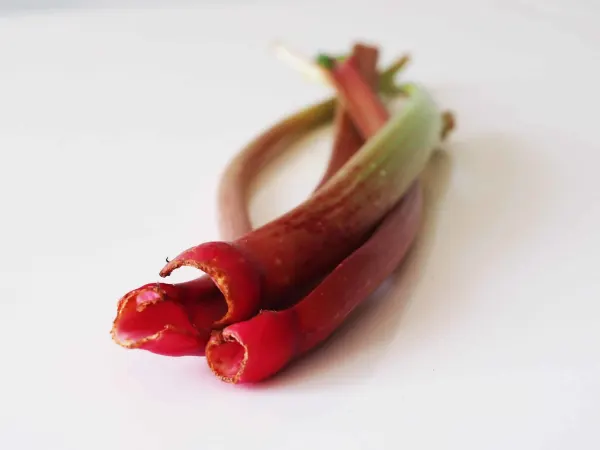Access our First Foods® Database in the Solid Starts App.
Learn moreRhubarb
Vegetable
Age Suggestion
6 months
Iron-Rich
No
Common Allergen
No

Warning
Rhubarb leaves are potentially toxic, but the plant’s stalks are edible. Also, excessive and consistent consumption of rhubarb may reduce the body’s ability to absorb essential nutrients like calcium and iron and distress the liver, gut, and kidney, particularly in those with existing kidney conditions. This may be due to rhubarb’s high concentration of oxalates, a naturally occurring plant compound that usually does not pose a problem when consumed in moderation.
When can babies eat rhubarb?
Rhubarb may be introduced as soon as a baby is ready to start solids, which is generally around 6 months of age. The leaves are potentially toxic, but the plant’s edible stalks are a great way to engage a baby’s senses with their assertive astringency, acidity, and texture.
How do you introduce rhubarb to babies with baby-led weaning?
Every baby develops on their own timeline, and the suggestions on how to cut or prepare particular foods are generalizations for a broad audience.
6 to 12 months old:
Cook chopped rhubarb stalks until soft and serve over scoopable foods like warm cereal, yogurt, ricotta, or even homemade whipped cream. Once you’ve safely introduced rhubarb, try the stalks in savory stews, serve alongside meats, or offer cooked rhubarb with any dish that could benefit from a tangy pop.
12 to 24 months old:
Continue serving chopped, cooked rhubarb stalks with scoopable foods and experiment with spices like cardamom, cinnamon, or ginger to balance the tart flavor. At this age many toddlers can manage raw rhubarb, however, consider slicing it thin to reduce choking risk. Alternatively, cook rhubarb with chopped strawberries to make compote or with onions, garlic, and spices to make chutney.
Videos
Is rhubarb a common choking hazard for babies?
No. Cooked rhubarb is not a common choking hazard, though raw rhubarb certainly could be. To minimize the risk, cook rhubarb until soft. As always, make sure to create a safe eating environment and stay within arm’s reach of baby during meals.
For more information on choking, visit our sections on gagging and choking and familiarize yourself with the list of common choking hazards.
Is rhubarb a common allergen?
No. Rhubarb is not a common allergen, and information on allergies to rhubarb is limited. There have been isolated case reports of individuals developing contact rashes after handling rhubarb or coming into direct contact with foods or medicines made from rhubarb, a condition known as phytodermatitis.
It is also possible to be allergic to windborne pollens produced by plants in the rhubarb family, but this is unlikely to cause issues after the ingestion of cooked rhubarb.
As you would when introducing any new food, start by offering a small amount at first. If there is no adverse reaction, gradually increase the amount served over future meals.
Is rhubarb healthy for babies?
Yes, in moderation. Rhubarb stalks contain essential nutrients like vitamin K for healthy blood and potassium for strong muscles and a robust nervous system and are full of fibers to stimulate a child’s digestive system and help strengthen the microbiome by keeping unwanted bacteria in check. Bonus: rhubarb stalks are comparable to kale and other greens when it comes to polyphenols, which are plant compounds that act as antioxidants and anti-inflammatory agents to keep the body healthy.
Despite its nutritional benefits, moderation is key. Excessive and consistent consumption of rhubarb may distress the liver, gut, and kidney, particularly in those with existing kidney conditions. This may be due to rhubarb’s high concentration of oxalates, a naturally occurring plant compound that usually does not pose a problem when consumed in moderation. When consumed in excess, oxalates can reduce the body’s ability to absorb essential nutrients like calcium and iron. Cooking helps reduce oxalates in rhubarb. If you have concerns, talk to a pediatric health care provider before serving rhubarb to a child.
★Tip: Rhubarb often shows up in sugary dishes and desserts–tempting ways to serve this tart plant to children, but it would be wise to press the pause button. Foods with added sugar are best served after the 2nd birthday so the child has ample time to develop a palate for unsweetened foods. Instead, serve rhubarb in a savory dish or pair rhubarb with a naturally sweet food, like carrot, strawberry, or stone fruit like apricots, cherries, nectarines, peaches, or plums.
Does it matter if the rhubarb is green or red?
No. Both green and red rhubarb stalks are edible. The color depends on growing conditions and the genetics of the variety, of which there are many. Prized garden varieties often have rosy pink or deep crimson stalks, while other plants produce speckled pink or pale green stalks that look like celery. Rhubarb leaves are potentially toxic, but the edible parts of the plant (the stalks and roots) have been used as food and medicine for thousands of years. The hardy perennial originated in Asia and grows worldwide in the wild and in gardens in temperate regions, where rhubarb is often celebrated as one of the first harvests of spring.
Use any color stalk in your cooking because all rhubarb stalks have a similar flavor: tart and tangy. Rhubarb’s acidity works in savory and sweet foods alike. Just be sure to check for freshness: the stalks should be firm and glossy, with no mushy areas or dark spots.
Written and reviewed by these specialists
J. Truppi, MSN, CNS
V. Kalami, MNSP, RD
K. Rappaport, OTR/L, MS, SCFES, IBCLC
S. Bajowala, MD, FAAAAI. (allergy section)
R. Ruiz, MD Board-Certified General Pediatrician and Pediatric Gastroenterologist
Expert Tips Delivered to Your Inbox
Sign up for weekly tips, recipes and more!
Copyright © 2025 • Solid Starts Inc

